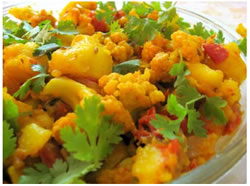I grew up in the Middle East, and I’ve always loved the flavours, aromas and textures of curries. On a beautiful spring day like today when I’ve spent the day working in the garden, there’s nothing easier or more nutritious than a curry.
Curcumin is one of the main ingredients of a curry. You may know it more commonly as turmeric. This versatile spice is antiangiogenic (click on the angiogenesis category to find out more about this) and has benefits for inflammatory diseases like arthritis as well as for diabetes and cancer.
There are three different types of curries – depending on the area the recipe comes from. We’re making a yellow curry today, but there are also red and green curries.
Red Curries
The typical Thai curry is red, and has a good balance of hot, sweet, sour, salty and bitter tastes. The heat can be controlled by the type and number of chilies added to the paste, and can be cooled down by adding coconut milk (a must for curries in my family’s opinion). Palm sugar is usually used to give that little sweetness. The main ingredients are garlic, shallots, red chilies, galangal, shrimp paste, salt, kaffir lime peel, coriander root, coriander seeds, cumin seeds, peppercorns and lemon grass. These ingredients form the base paste to which you can add the vegetables, fruit, meat or fish of your choice.
Yellow Curries
This curry is richer and creamier than the red curry, because of the addition of coconut cream as well as coconut milk. Because of the richness, it tends to not taste as spicy. The primary spices are cumin, coriander, turmeric, fenugreek, garlic, salt, bay leaf, lemon grass, cayenne pepper, ginger, mace and cinnamon.
Green Curries
Green curries tend to be as hot as red curries; however, despite their heat they have a sweetness that is not usually associated with red curries. The main ingredients for the sauce consist of coconut milk, green chilies, shallots, garlic, galangal, kaffir lime peel, roasted coriander and cumin seeds, white peppercorns and shrimp paste.
Aloo Gobi with saffron rice
This recipe was given to me during my cooking course at IHN by Kamsella Nadoo who has since left Toronto for Vancouver I believe. Anyway, its a family favourite and I hope that you enjoy it too.
Step 1
2 Tbsp coconut oil (or ghee)
3 tsp mustard seeds
Put the two together in a covered saucepan on medium heat and leave until the seeds start to pop. Then add
3 tsp urad dhal (like lentils but cook faster – you can replace with 1 can of chick peas which I do often)
Cook for 1-2 minutes.
Step 2
Add
10 curry leaves (or you can use 2 Tbsp curry powder – Lala’s is my favourite brand)
3 dried whole chilies (I’ll be hones and say that I often use a combination of cayenne pepper – not much – and Asian chili sauce as I find whole chilies a little strong for me)
1 tsp turmeric
Cook 1 minute stirring to form a nice paste.
Step 3
Add 1 head cauliflower – chopped into bite-sized pieces
3 large potatoes – I leave the skins on but chop into bite-sized pieces
1 1/4 tsp salt.
Cook covered on low heat for 20 minutes. Garnish with shredded coconut and fresh coriander.
Saffron Rice
2 Tbsp coconut oil or ghee
1 tsp cumin seeds
3 large pinches saffron
Warm spices for 1-2 minutes until fragrant (medium heat)
Add rice (1 cup of basmati rice) and stir and cover for 2 minutes.
Add 2 cups of water (or a combo of half water, half vegetable stock) and boil for 5 minutes, then turn it down to a low simmer – cover and leave for 10 minutes until all of the liquid is absorbed. Once the liquid is absorbed, add 1 can of coconut milk and let simmer again.
At the last minutes, stir in 1/2 red pepper chopped very small, and green peas just until softened. I find that once I add the vegetables to the rice, I call the children to set the table and that’s lots of time.
Notes from last nights dinner:
I replaced the salt with kombu in the soup, and before I added it to the rice noodles it was perfect. But the rice noodles on their own were a little bland (instructions on the package said to pour boiling water over them and leave for 20 minutes). Next time I’ll add some kombu to that water too or a little sea salt for more depth of flavour to the whole meal.
Thanks to Longos “experience” magazine, Spring 2011 issue for the article on curries pp. 34 – 35

